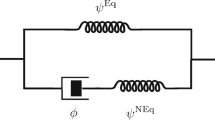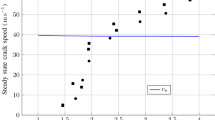Abstract
In a recent contribution, Kumar et al. (J Mech Phys Solids 112:523–551, 2018) have introduced a macroscopic theory aimed at describing, explaining, and predicting the nucleation and propagation of fracture and healing in elastomers undergoing arbitrarily large quasistatic deformations. The purpose of this paper is to present an alternative derivation of this theory—originally constructed as a generalization of the variational theory of brittle fracture of Francfort and Marigo (J Mech Phys Solids 46:1319–1342, 1998) to account for physical attributes innate to elastomers that have been recently unveiled by experiments at high spatio-temporal resolution—cast as a phase transition within the framework of configurational forces. A second objective of this paper is to deploy the theory to probe new experimental results on healing in silicone elastomers.






Similar content being viewed by others
Notes
The extension of the present formulation to the case of any number of phases is straightforward.
Throughout this work, we focus on isothermal processes.
The partial derivative with respect to the configurational variable z should be interpreted as a constrained derivative since \(0\le z \le 1\).
For instance, it is possible that the elasticity—and not just the toughness—of the elastomer also evolves with the cumulative history of fracture and healing.
In addition to internal microscopic defects throughout its volume, a given piece of elastomer will feature as well surface microscopic defects on its boundary. Depending on the geometry of the piece and the applied loading conditions, accounting for those may also be essential in order to describe correctly the nucleation of macroscopic fracture.
Here, it is important to emphasize that the PDMS elastomer used in the experiment, featuring a 30:1 ratio of base to curing agent, is a solid capable of some viscous dissipation. Consequently, its idealization as a nonlinear elastic solid in the theory may cause some disagreement between the predictions from the theory and the experimental observations.
We recall that smaller positive values in the healing branch of the toughness function \(k(\dot{z},\alpha , t^*)\) imply that the material exhibits a higher resistance to heal. Again, non-positive values imply that healing is prohibited altogether; see Remark 4 in Kumar et al. (2018).
References
Alicandro R, Cicalese M, Gloria A (2011) Integral representation results for energies defined on stochastic lattices and application to nonlinear elasticity. Arch Ration Mech Anal 200:881–943
Borden MJ (2012) Isogeometric analysis of phase-field models for dynamic brittle and ductile fracture. University of Texas at Austin Ph.D. Thesis
Bourdin B, Francfort GA, Marigo JJ (2000) Numerical experiments in revisited brittle fracture. J Mech Phys Solids 48:797–826
Bourdin B, Francfort GA, Marigo JJ (2008) The variational approach to fracture. J Elast 91:5–148
Braides A (1998) Approximation of free-discontinuity problems. Springer, Berlin
Francfort GA, Marigo JJ (1998) Revisiting brittle fracture as an energy minimization problem. J Mech Phys Solids 46:1319–1342
Fried E, Gurtin ME (1994) Dynamic solid-solid transitions with phase characterized by an order parameter. Physica D 72:287–308
Gent AN (1990) Cavitation in rubber: a cautionary tale. Rubber Chem Technol 63:49–53
Gent AN, Lindley PB (1959) Internal rupture of bonded rubber cylinders in tension. Proc R Soc A 249:195–205
Gent AN, Park B (1984) Failure processes in elastomers at or near a rigid inclusion. J Mater Sci 19:1947–1956
Gloria A, Le Tallec P, Vidrascu M (2014) Foundation, analysis, and numerical investigation of a variational network-based model for rubber. Continuum Mech Thermodyn 26:1–31
Griffith AA (1921) The phenomena of rupture and flow in solids. Philos Trans R Soc Lond A 221:163–198
Gurtin ME (1996) Generalized Ginzburg–Landau and Cahn–Hilliard equations based on a microforce balance. Physica D 92:178–192
Kumar A, Lopez-Pamies O (2016) On the two-potential constitutive modelling of rubber viscoelastic materials. Comptes Rendus Mecanique 344:102–112
Kumar A, Aranda-Iglesias D, Lopez-Pamies O (2017) Some remarks on the effects of inertia and viscous dissipation in the onset of cavitation in rubber. J Elast 126:201–213
Kumar A, Francfort GA, Lopez-Pamies O (2018) Fracture and healing of elastomers: a phase-transition theory and numerical implementation. J Mech Phys Solids 112:523–551
Lefèvre V, Ravi-Chandar K, Lopez-Pamies O (2015) Cavitation in rubber: an elastic instability or a fracture phenomenon? Int J Fracture 192:1–23
Lopez-Pamies O (2010) A new \(I_1\)-based hyperelastic model for rubber elastic materials. Comptes Rendus Mecanique 338:3–11
Mullins L (1959) Rupture of rubber. IX. Role of hysteresis in the tearing of rubber. Trans Inst Rubber Ind 35:213–222
Nguyen QS, Andrieux S (2005) The non-local generalized standard approach: a consistent gradient theory. Comptes Rendus Mecanique 333:139–145
Parikh N, Boyd S (2013) Proximal algorithms. Found Trends Optim 1:123–231
Pham K, Amor H, Marigo JJ, Maurini C (2011) Gradient damage models and their use to approximate brittle fracture. Int J Damage Mech 20:618–652
Poulain X, Lefèvre V, Lopez-Pamies O, Ravi-Chandar K (2017) Damage in elastomers: nucleation and growth of cavities, micro-cracks, and macro-cracks. Int J Fracture 205:1–21
Poulain X, Lopez-Pamies O, Ravi-Chandar K (2018) Damage in elastomers: healing of internally nucleated cavities and micro-cracks. Soft Matter 14:4633–4640
Sicsic P, Marigo JJ (2013) From gradient damage laws to Griffith’s theory of crack propagation. J Elast 113:55–74
Treloar LRG (2005) The physics of rubber elasticity. Clarendon Press, Oxford
Ziegler H, Wehrli C (1987) The derivation of constitutive relations from the free energy and the dissipation function. Adv Appl Mech 25:183–238
Acknowledgements
Support for this work by the National Science Foundation through the Grant DMS–1615661 is gratefully acknowledged.
Author information
Authors and Affiliations
Corresponding author
Additional information
Publisher's Note
Springer Nature remains neutral with regard to jurisdictional claims in published maps and institutional affiliations.
Electronic supplementary material
Below is the link to the electronic supplementary material.
Rights and permissions
About this article
Cite this article
Kumar, A., Ravi-Chandar, K. & Lopez-Pamies, O. The configurational-forces view of the nucleation and propagation of fracture and healing in elastomers as a phase transition. Int J Fract 213, 1–16 (2018). https://doi.org/10.1007/s10704-018-0302-y
Received:
Accepted:
Published:
Issue Date:
DOI: https://doi.org/10.1007/s10704-018-0302-y




